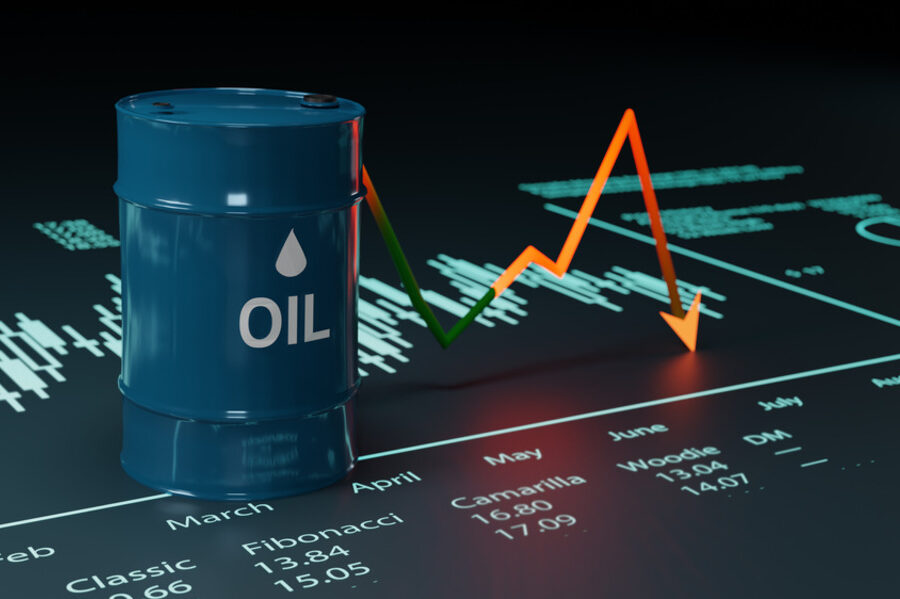In the intricate, interconnected machinery of the global economy, few variables wield as much power and cause as much widespread disruption as the price of oil. When the market for this indispensable commodity experiences sudden and dramatic shifts, it sends oil price shocks rippling through every facet of the global system, profoundly affecting industries, nations, and individual consumers. These shocks, whether a sharp spike or a precipitous drop, have a far-reaching economic ripple, influencing everything from inflation and monetary policy to international relations and consumer behavior. Understanding the mechanisms behind these shocks, their diverse impacts, and the strategies for navigating their aftermath is crucial for policymakers, business leaders, and every citizen who feels the pinch at the pump.
The Indispensable Commodity

Oil is more than just fuel for our cars; it is the lifeblood of the modern global economy. Its uses are so fundamental and pervasive that its price directly impacts the cost of virtually all goods and services.
A. The Pervasive Role of Oil in the Economy
The influence of oil extends far beyond the energy sector, touching every aspect of our lives in often-unseen ways.
- Transportation: This is the most visible use. The price of oil directly determines the cost of gasoline, diesel, and jet fuel, impacting daily commutes, logistics, global trade, and travel. A rise in oil prices immediately increases the cost of shipping goods, from raw materials to finished products.
- Manufacturing and Production: Oil is a key raw material for countless products. Plastics, fertilizers, synthetic fibers, pharmaceuticals, and chemicals are all petroleum-based. A price shock in oil directly impacts the cost of production across a vast array of manufacturing industries.
- Agriculture: Modern agriculture is heavily reliant on oil. Fuel is needed to power farm machinery, and natural gas, a byproduct of oil extraction, is a key component in the production of nitrogen-based fertilizers. A rise in oil prices translates to higher food production costs.
- Electricity Generation: While many countries have diversified their energy sources, oil remains a significant fuel for electricity generation, especially in certain regions or for backup power.
- Geopolitical Influence: Nations that are major oil producers or consumers wield significant geopolitical influence. Oil supply and price are often tied to international conflicts, trade agreements, and political stability, adding a layer of complexity and unpredictability to global markets.
B. The Causes of Oil Price Shocks
Oil price shocks are rarely random events. They are typically triggered by a sudden and dramatic imbalance between global supply and demand.
- Supply-Side Shocks: These are often the most dramatic and are typically caused by geopolitical events.A. Political Instability: Wars, revolutions, or civil unrest in major oil-producing regions (e.g., the Middle East) can lead to a sudden disruption of supply. The 1973 oil crisis, triggered by an Arab oil embargo, is a classic example.B. OPEC Decisions: The Organization of the Petroleum Exporting Countries (OPEC) can collectively decide to increase or decrease oil production, which has a significant and immediate impact on global supply and price.C. Natural Disasters: Hurricanes, earthquakes, or other natural disasters in major oil-producing regions can damage infrastructure, such as refineries or pipelines, disrupting the supply chain.
D. Terrorism or Sabotage: Attacks on oil infrastructure can cause significant supply disruptions.
- Demand-Side Shocks: These are often driven by major economic events.A. Sudden Economic Growth: An unexpected and rapid boom in a major economy (e.g., China’s rapid industrialization) can lead to a surge in demand that outpaces supply, pushing prices up.B. Global Economic Downturns: A severe recession or a global financial crisis can cause a dramatic drop in demand for energy, leading to a sharp decline in oil prices. The 2008 financial crisis and the COVID-19 pandemic are key examples.C. Technological Innovation: Long-term shifts, such as the increasing adoption of electric vehicles, can reduce demand for oil over time, influencing price trends.
- Speculation in Financial Markets: The oil market is also a financial market. Speculation by traders, hedge funds, and other financial players can amplify price movements, sometimes detached from the underlying fundamentals of supply and demand.
The Consequences of a Price Shock
When an oil price shock occurs, its effects are not confined to a single sector; they reverberate throughout the entire global economic system, causing a cascade of consequences.
A. The Impact of a Price Spike
A sudden and sharp increase in the price of oil is often the most feared type of shock, as it directly impacts inflation and consumer spending.
- Inflationary Pressure:A. Cost-Push Inflation: A rise in oil prices is a classic example of cost-push inflation. As the cost of fuel and raw materials increases, businesses are forced to raise their prices to maintain profitability. This impacts everything from food and goods to services and transportation.B. Monetary Policy Response: Central banks often respond to this inflation by raising interest rates, which can slow down economic growth and lead to a recession.
- Reduced Consumer Spending:A. Erosion of Purchasing Power: As gasoline prices rise, consumers have less discretionary income to spend on other goods and services, which can hurt sectors like retail, hospitality, and entertainment.B. Decline in Confidence: High energy costs can erode consumer and business confidence, leading to a slowdown in investment and hiring.
- Impact on Industries:A. Airline and Logistics: The airline and shipping industries, which are heavily reliant on fuel, are particularly vulnerable. A price spike can decimate their profit margins and force them to raise prices, which can reduce travel and trade.B. Manufacturing: Manufacturing industries that use oil as a raw material or for energy face higher production costs, which can lead to a decline in output and competitiveness.C. Oil-Dependent Nations: For nations that are net oil importers, a price spike can lead to a trade deficit, currency depreciation, and a decline in economic growth.
D. Oil-Producing Nations: Nations that are net oil exporters benefit from a price spike, experiencing a surge in revenue that can boost their economy, but also exposes them to the risks of a “resource curse” if not managed wisely.
B. The Impact of a Price Drop
A sudden and sharp decline in the price of oil, while seemingly beneficial, can also have a significant and often negative economic ripple.
- Deflationary Pressure: A drop in oil prices reduces the cost of fuel and raw materials, which can lower prices for consumers and producers. While this sounds good, a prolonged period of deflation can lead to a slowdown in spending and investment, as consumers and businesses delay purchases in anticipation of even lower prices.
- Impact on Energy Sector:A. Job Losses: A low oil price makes many oil and gas exploration and production projects unviable, leading to massive layoffs in the energy sector and related industries.B. Decline in Investment: The energy sector, which is a major driver of capital investment, can see a significant decline in investment, which has a ripple effect on the broader economy.C. Financial Instability: Companies in the energy sector that have taken on debt may struggle to service it, leading to bankruptcies and financial instability.
- Impact on Oil-Producing Nations:A. Reduced Revenue: Nations that are highly dependent on oil exports can see a dramatic decline in government revenue, which can lead to budget deficits, social unrest, and a decline in public services.B. Currency Depreciation: A drop in oil prices can lead to a sharp depreciation of the currency in oil-exporting nations, increasing inflation and economic instability.
- Mixed Impact on Consumer Spending: While lower prices at the pump can boost consumer spending in some sectors, the fear of economic instability and job losses in the energy sector can often offset this benefit.
Strategies for Resilience

Given the profound impact of oil price shocks, nations and businesses have developed various strategies to mitigate their effects and build economic resilience.
A. Strategies for Nations and Policymakers
- Diversification of Energy Sources: Nations can reduce their dependence on oil by investing in renewable energy sources like solar, wind, and geothermal. This not only provides greater energy security but also helps to combat climate change.
- Strategic Petroleum Reserves: Many countries maintain a strategic petroleum reserve to use in case of a major supply disruption. This provides a buffer that can help stabilize prices in the short term.
- Monetary Policy Tools: Central banks can use their monetary policy tools (e.g., interest rate adjustments) to manage the inflationary or deflationary pressures of an oil price shock.
- Fiscal Policy: Governments can use fiscal policy (e.g., tax cuts, subsidies, public spending) to offset the negative impacts of an oil price shock on consumers and businesses.
- Currency Hedging: Nations can use financial instruments to hedge against the risks of currency depreciation caused by a drop in oil prices.
- Diversification of the Economy: For oil-exporting nations, the most important long-term strategy is to diversify their economy away from oil, investing in sectors like technology, finance, and tourism to reduce their dependence on a single commodity.
B. Strategies for Businesses
- Hedging: Companies that are heavily reliant on oil (e.g., airlines, shipping companies) can use financial instruments to hedge against the risk of a price spike. This involves buying oil futures or other derivatives to lock in a price for a future purchase.
- Operational Efficiency: Companies can invest in technologies and practices that improve their energy efficiency, reducing their reliance on oil and other energy sources. This could involve investing in more fuel-efficient fleets, optimizing logistics, or improving energy use in manufacturing processes.
- Diversification of Supply Chains: Companies can diversify their supply chains to reduce their dependence on a single supplier or a single region, which makes them less vulnerable to supply-side shocks.
- Pass-Through Costs: For some businesses, the best strategy is to simply pass on the increased costs to their customers. This is often the case for industries with low-profit margins.
- Inventory Management: Companies can use sophisticated inventory management systems to optimize their inventory levels, ensuring they have enough stock to meet demand without overstocking, which can be costly in a volatile market.
- Focus on Value: In a high-price environment, businesses can focus on providing greater value to their customers, which can help to justify a higher price point.
- Flexible Pricing Models: Companies can adopt flexible pricing models that allow them to adjust prices quickly in response to changes in energy costs.
C. Strategies for Consumers
- Energy Efficiency: Consumers can reduce their energy consumption by investing in more fuel-efficient vehicles, using public transportation, or improving the energy efficiency of their homes.
- Budgeting and Saving: Consumers can prepare for a price shock by creating a budget and saving money in a rainy-day fund. This provides a buffer that can help them weather a period of high inflation or job instability.
- Investing in Diversified Portfolios: For those with investments, a diversified portfolio that is not overly dependent on a single sector (e.g., energy) is the best strategy to mitigate risk.
- Adapting to Change: Consumers can adapt to a high-price environment by changing their behavior, such as carpooling, reducing non-essential travel, or adjusting their thermostat.
The Future of Oil and the Economic Ripple
While the world is moving toward a more sustainable and diversified energy future, oil will remain a critical commodity for decades to come. The future of oil price shocks will be shaped by a new set of factors, including the pace of the energy transition, geopolitical shifts, and the rise of new technologies.
A. The Energy Transition
- The Decline of Oil: As the world moves toward renewable energy, the demand for oil will eventually decline, which could lead to a long-term downward pressure on prices.
- The Role of Renewables: The increasing adoption of renewable energy will provide greater energy security and reduce the world’s vulnerability to supply-side shocks.
- The Transition Period: The transition to a clean energy future will not be smooth. It will be a period of volatility and uncertainty, with oil price shocks still possible due to a mismatch between supply and demand.
B. The Geopolitical Chessboard
- New Players: New players in the energy market, such as the United States’ rise as a major oil producer, are changing the geopolitical landscape and the influence of traditional players like OPEC.
- Political Instability: Political instability in oil-producing regions will remain a key factor in future price shocks.
- Geopolitical Tensions: Geopolitical tensions between major powers could also lead to supply disruptions and price volatility.
C. The Role of Technology
- AI and Data: The use of AI and data analytics will make it easier to forecast oil supply and demand, which could help to reduce price volatility.
- Technological Innovation: Technological innovations, such as new drilling techniques, will also impact the supply side of the equation.
- The Rise of Electric Vehicles: The widespread adoption of electric vehicles will be a major long-term factor in the decline of oil demand.
Conclusion
The price of oil is a powerful force that sends shockwaves through the global economy. When oil price shocks occur, the economic ripple is profound and far-reaching, impacting inflation, consumer spending, and international relations. These shocks, whether a spike or a drop, are a testament to the world’s deep and ongoing dependence on this single commodity.
However, as the world moves toward a more diversified and sustainable energy future, nations, businesses, and individuals are developing new strategies for resilience. From investing in renewable energy and building strategic reserves to using financial instruments to hedge against risk and adopting more energy-efficient practices, we are learning to navigate this volatile landscape. The future of oil is a story of transition and transformation, but for the foreseeable future, its price will remain a critical factor in the health and stability of the global economy. The ability to understand and respond to these shocks is no longer a luxury; it is a necessity for a resilient and prosperous future.






